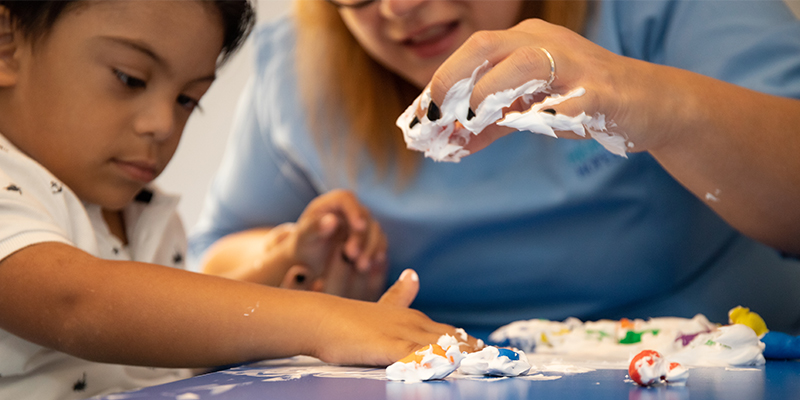Hand dominance or hand preference is a common topic of discussion in our Occupational Therapy sessions. Parents often ask us when a child should have a dominant hand and how important it is for this dominance to be followed. This blog post will explain how hand dominance develops and how to support hand dominance in children both with and without physical disabilities. We will focus on developmental phases rather than ages as each child develops at their own pace.
The hands are an integral part of our understanding of the world. They have many sensory receptors that process a considerable amount of information to help us manipulate objects and comprehend our environment. Hand use starts in utero when the fetus sucks its thumb to build awareness of their touch system and hand-mouth coordination. We see newborns reaching out to touch their parent, to then touching a toy, then holding the toy, exploring the toy with their hands and mouth and eventually using just hands to explore their surroundings.
Before developing a dominant hand, a child first learns how to use one hand to manipulate an object and then how to use two hands together. A child will typically start to explore objects around them using their hands when they develop head control. They will start to reach out with the right hand on the right side and left hand on the left side to grab objects and bring them to their mouths to explore. We don’t expect to see the child crossing the midline (using right hand on left side/left hand on right side) at this stage. The child is learning to control their hand movements in symmetrical patterns (same side).
Some ideas to promote single-hand use include:
- Shaking rattles;
- Reaching for bubbles;
- Reaching a bottle or spoon;
- Lying on one side to reach a toy; and,
- Knocking over a block tower.
Once the child is confident using one hand at a time to explore, and once they become stronger to sit alone, they will begin to bring hands together. Using two hands together opens a new world of experimentation for the child, and you may notice them become more interested in manipulating objects at this stage. When first learning to use hands together, the child will be using their hands to perform the same action–there is no dominant hand. They will still explore using one hand at a time but will gradually bring hands together at their midline to play with a toy. When they become confident to hold or explore a toy at midline, they will then learn to bang toys together (taking hands away from the midline and then back towards the midline) and learn to clap their hands.
Some ideas to promote using both hands at midline include:
- Sitting up to hold a ball;
- Singing songs with actions performed at midline such as Pat-a-cake and The Wheels on the Bus;
- Clapping along to music;
- Banging two blocks together; and,
- Using two hands to hold a cup.
Once the child can bring hands together at midline to confidently manipulate and explore, we expect them to start using one hand to lead a task while the other hand supports or stabilises. This is also around the time your child might start crawling or standing up to walk along your furniture. They are learning to use both sides of the body to complete different tasks as the same time. This is called asymmetrical movement and is part of bilateral coordination. However, the movements are now more complex and require the left and right sides of the body to coordinate and sequence movements at slightly different speeds or in a slightly different way. You may begin to see a hand preference developing at this point, but it will not be a dominance yet.
Some ideas to support your child’s bilateral coordination at this stage of development include:
- Pulling playdough apart to search for a hidden toy;
- Using construction blocks like Duplo;
- Pouring water or sand;
- Playing with hammer toys; and,
- Threading beads onto a rod or lace.
When your child is using their hands confidently for bilaterally coordinated movements, they will begin to form a dominance. Hand dominance typically develops between the ages of 3 to 6 years, with most 4-year-olds showing a dominance. 90% of the adults reading this post are right-handed, as only 10% of the adult population is left-handed. Some adults are ambidextrous and swap between hands, yet they still exhibit a preference for either right- or left-hand use. Many children will swap hands to complete tasks–which is acceptable, especially for new tasks–however, there should be a dominance forming so they can learn to master skills such as handwriting and using eating utensils. If your child is still unsure of which hand to use, present items to them at the middle of their body and allow them to choose which hand they feel comfortable with. Never force them to use a hand.
Children with physical disabilities may still follow this same trajectory of hand skills development but there will be some cases where this is not possible. Children with deformities, abnormal muscle tone, paralysis/hemiplegia and other physical irregularities may not have a choice of which hand to use. Naturally, we would use the more able hand to develop manipulation skills and eventually this would be the dominant hand. In these instances, it is important to support your child’s bilateral coordination development by making adaptations to the toys so your child can access them.
If your child is not showing a dominance, you may spend at least one full week taking data of how your child is using their hands across all routines and activities–this is the approach we use in therapy. Present items to your child’s midline and notice which hand they will try to reach with first and then which hand completes the task. You may start out by thinking your child prefers their right hand but once you begin collecting data you may see more of a preference to the left. By collecting this data, you will have a clearer idea of which hand to start supporting as the dominant side.
If you have questions about our child’s hand dominance, please reach out to our Occupational Therapy team who will be able to help you better understand your child’s needs.




